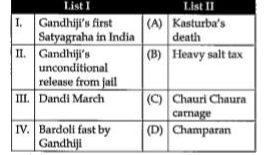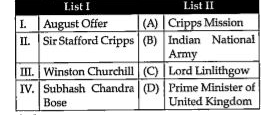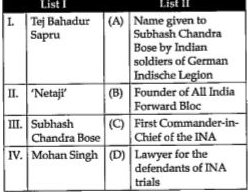Match List I with List II and select the correct answer using the codes given below the lists :
List IList IIa.(SiH3)3Ni.3 centre -2-electron bondb.BF3ii.sp3−hybridizationc.SiO2iii.pπ−pπ bondd.B2H6iv.pπ−dπ bond
:
The correct Answer is:3
To solve the problem of matching List I with List II, we will analyze each compound in List I and determine its corresponding bond type or hybridization from List II.
1. Identify Compound (a): SiH₃₃N
- Analysis: Silicon (Si) has vacant d-orbitals. The lone pair of electrons on the nitrogen atom can undergo back bonding with Si, leading to the formation of a p pi-d pi bond.
- Match: This corresponds to option (iv) "p pi-d pi bond".
- Result: a → iv
2. Identify Compound (b): BF₃
- Analysis: Boron (B) in BF₃ is sp² hybridized. The bonding involves the p orbitals of boron and fluorine, leading to p pi-p pi bonds.
- Match: This corresponds to option (iii) "p pi-p pi bond".
- Result: b → iii
3. Identify Compound (c): SiO₂
- Analysis: Silicon dioxide (SiO₂) has silicon in an sp³ hybridization state. The structure involves tetrahedral geometry with four bonds formed.
- Match: This corresponds to option (ii) "sp³ hybridization".
- Result: c → ii
4. Identify Compound (d): B₂H₆
- Analysis: In diborane (B₂H₆), there are three-center two-electron bonds (banana bonds) formed between the boron and hydrogen atoms.
- Match: This corresponds to option (i) "3 center-2-electron bond".
- Result: d → i
Final Summary of Matches:
- a → iv (p pi-d pi bond)
- b → iii (p pi-p pi bond)
- c → ii (sp³ hybridization)
- d → i (3 center-2-electron bond)
Final Answer:
The correct matching is:
- a - iv
- b - iii
- c - ii
- d - i
Thus, the final answer in code form is: 4 3 2 1.
---
- Analysis: Silicon (Si) has vacant d-orbitals. The lone pair of electrons on the nitrogen atom can undergo back bonding with Si, leading to the formation of a p pi-d pi bond.
- Match: This corresponds to option (iv) "p pi-d pi bond".
- Result: a → iv
- Analysis: Boron (B) in BF₃ is sp² hybridized. The bonding involves the p orbitals of boron and fluorine, leading to p pi-p pi bonds.
- Match: This corresponds to option (iii) "p pi-p pi bond".
- Result: b → iii
- Analysis: Silicon dioxide (SiO₂) has silicon in an sp³ hybridization state. The structure involves tetrahedral geometry with four bonds formed.
- Match: This corresponds to option (ii) "sp³ hybridization".
- Result: c → ii
- Analysis: In diborane (B₂H₆), there are three-center two-electron bonds (banana bonds) formed between the boron and hydrogen atoms.
- Match: This corresponds to option (i) "3 center-2-electron bond".
- Result: d → i
- a → iv (p pi-d pi bond)
- b → iii (p pi-p pi bond)
- c → ii (sp³ hybridization)
- d → i (3 center-2-electron bond)
The correct matching is:
- a - iv
- b - iii
- c - ii
- d - i
Topper's Solved these Questions
- P BLOCK ELEMENTSBOOK - RESONANCE ENGLISHCHAPTER - P BLOCK ELEMENTSEXERCISE - INORGANIC CHEMISTRY(P-Block Elements)
35 Videos
- P BLOCK ELEMENTSBOOK - RESONANCE ENGLISHCHAPTER - P BLOCK ELEMENTSEXERCISE - Example
30 Videos
- NUCLEAR CHEMISTRYBOOK - RESONANCE ENGLISHCHAPTER - NUCLEAR CHEMISTRYEXERCISE - STAGE-II
1 Videos
- P-BLOCK ELEMENT (BORON AND CARBON FAMILY)BOOK - RESONANCE ENGLISHCHAPTER - P-BLOCK ELEMENT (BORON AND CARBON FAMILY)EXERCISE - PART - III : OLYMPIAD PROBLEMS (PREVIOUS YEARS) STAGE - V (INTERNATIONAL CHEMISTRY OLYMPIAD (IChO)) Problem 3
8 Videos
Similar Questions
Knowledge Check
Match List I with List II and select the correct answer by using the codes given below the lists:
 AI-D, II - A, III -B, IV-CBI-A, II – D, III -C, IV-BCI-A, II – D, III – B, IV-CDI-D, II -C, III – B, IV-A
AI-D, II - A, III -B, IV-CBI-A, II – D, III -C, IV-BCI-A, II – D, III – B, IV-CDI-D, II -C, III – B, IV-AMatch List I with List II and select the correct answer by using the codes given below the lists:

 AI-D, II - A, III - C, IV-BBI-B, II - D, III-A, IV-CCI-A, II – D, III – B, IV-CDI-D, II-A, III -B, IV-C
AI-D, II - A, III - C, IV-BBI-B, II - D, III-A, IV-CCI-A, II – D, III – B, IV-CDI-D, II-A, III -B, IV-CMatch List I with List II and select the correct answer by using the codes given below the lists:
 AI-D, II – A, III - C,IV-BBI-A, II-D, III -C, IV-BCI-A, II -D, III - B, IV-CDI-D, II-A, III -B, IV-C
AI-D, II – A, III - C,IV-BBI-A, II-D, III -C, IV-BCI-A, II -D, III - B, IV-CDI-D, II-A, III -B, IV-C
Match List I with List II and select the correct answer by using the codes given below the lists:

View SolutionMatch List I with List II and select the correct answer by using the codes given below the lists:

View SolutionMatch List I with List II and select the correct answer by using the codes given below the lists:

View SolutionMatch List I with List II and select the correct answer by using the codes given below the lists :

View SolutionMatch List I with List II and select the correct answer by using the codes given below the lists :

View Solution


